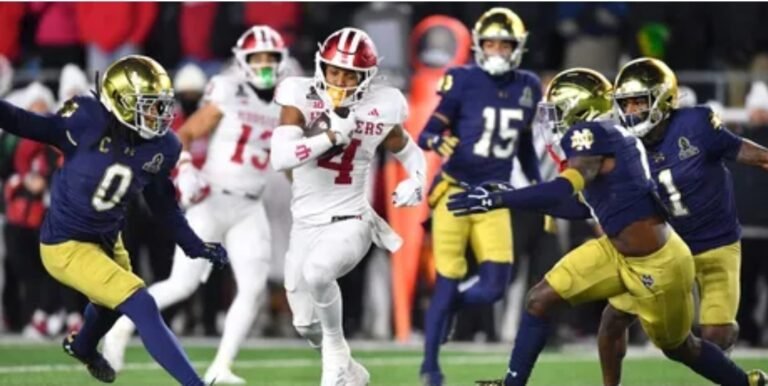In a recent analysis of the 2026 College Football Playoff (CFP) projections, ESPN’s experts have notably placed the Indiana Hoosiers outside the top contenders, sparking discussions among fans and analysts alike.
Despite a commendable season, Indiana finds itself ranked just outside the crucial top four positions in several expert predictions.
Andrea Adelson, a prominent ESPN analyst, lists her top four teams as Oregon, Georgia, Arizona State, and Boise State, with Indiana positioned at number 10. Similarly, Kyle Bonagura’s rankings feature Oregon, Georgia, Boise State, and Arizona State in the top spots, placing Indiana at the 10th position as well. Bill Connelly echoes this sentiment, ranking Indiana ninth, with his top four comprising Oregon, Georgia, Arizona State, and Boise State.
These rankings have raised eyebrows, especially considering Indiana’s impressive performance throughout the season. The Hoosiers have showcased a strong offense and a resilient defense, leading many to believe they deserved a higher spot in the CFP predictions.
The CFP selection process has always been a topic of debate, with factors such as strength of schedule, head-to-head results, and conference championships playing pivotal roles. Indiana’s placement outside the top four suggests that, despite their strong record, other elements may have influenced the analysts’ decisions.
It’s also worth noting that discussions are underway about further expanding the CFP. According to a report from ESPN’s Pete Thamel, a 14-team model has been considered among officials and could be adopted as early as 2026. This potential expansion might provide teams like Indiana with a better opportunity to compete for the national championship in the future.
The current 12-team playoff format, which includes the five highest-ranked conference champions and the next seven highest-ranked teams, was designed to offer more teams a shot at the title. However, as the recent predictions indicate, even with an expanded field, competition remains fierce, and traditional powerhouses often dominate the top spots.
Indiana’s journey this season has been nothing short of remarkable. Their offense has been led by a dynamic quarterback-receiver duo, while the defense has consistently thwarted opposing teams’ advances. Key victories against ranked opponents have bolstered their resume, making their lower-than-expected ranking a point of contention among supporters.
Critics argue that the CFP selection process tends to favor established programs with historical success, potentially overshadowing emerging teams that have demonstrated excellence in a given season. Indiana’s current predicament seems to underscore this perspective, as their achievements have not translated into a top-four ranking.
As the season progresses and with potential changes on the horizon for the CFP structure, teams like Indiana will be closely monitoring developments. The possibility of a 14-team playoff offers hope for greater inclusivity and recognition of deserving programs that may currently be on the cusp of contention.
In conclusion, while ESPN’s recent CFP predictions have placed Indiana outside the top four, the Hoosiers’ impressive season cannot be overlooked. The ongoing discussions about playoff expansion may soon provide teams like Indiana with the platform they need to compete at the highest level and challenge the traditional power dynamics of college football.



